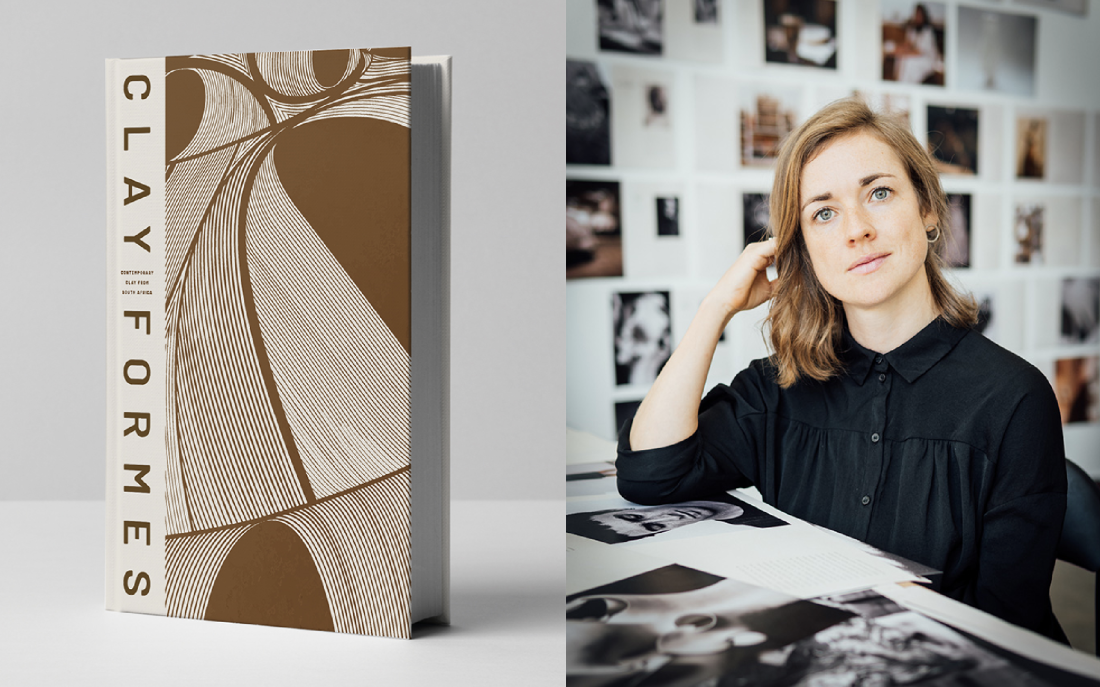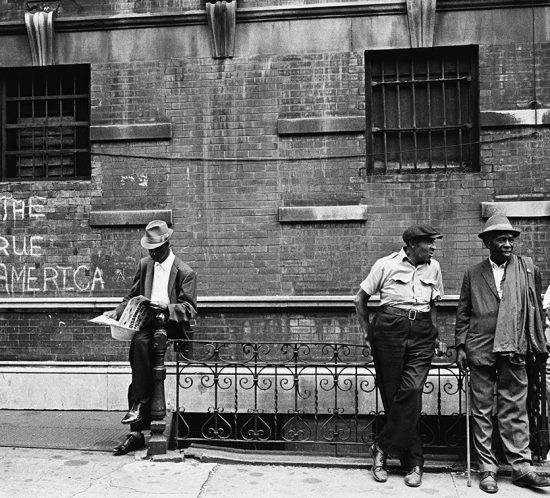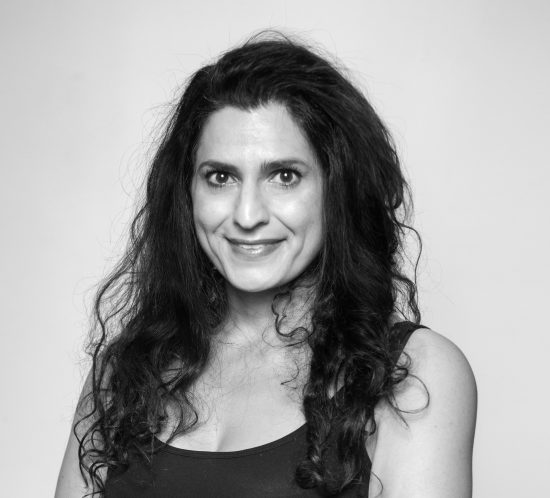Feat of clay
A much-needed addition to any art lover’s book stash, Clay Formes: Contemporary Clay from South Africa explores the studios of thirty local artists. Published by South African art historian Olivia Barrell, it includes familiar names including Katherine Glenday, Zizipho Poswa, Ruan Hoffmann and Ben Orkin. We dive into its pages and present the work of five featured artists in these extracts from the book.
The large majority of artists featured in this publication have been working with clay for most of their adult lives and have a profound understanding of the medium and its technical capabilities – regarding the latter, it is precisely this element that has often been pushed to its edge to create many of the works documented here. This would not be possible without the years of dedication and ritual demanded by a medium that is temperamental, complex and extremely difficult to master. Crucial to the essence of this book is this sentiment by contemporary Israeli ceramic artist Ester Beck:
“I was a ‘potter’ – once. The potter is still there, in the subconscious, with key concepts like ‘opening’, ‘faceting-fluting’, remaining there in abstraction; but ‘centering’, centrifugal movement of the wheel, and lifting and thinning of walls are all gone: now I myself am revolving around a block of clay and around the object being formed.”
Each of the artists in this publication has somehow been formed by clay, both shaping the medium and being shaped by it over time. Clay, defined as “an earthy material that is plastic when moist but hard when fired,” holds the duality of two states: formed and unformed, hard and soft. This publication is about the metamorphosis of clay, illustrating much of what the medium can become: canvas, voice, eggshell, stone, sand, artefact, plastic, wood, metal, or metaphor. This book is the first of its kind – a lengthy dedication to sculptural clay within contemporary South African art. There has been a small handful of publications providing an overview of South African ceramics – such as Garth Clark’s Potters of Southern Africa (1974) and Wilma Cruise’s Contemporary Ceramics in South Africa (1991), which stands as the latest to date – but these group both sculptural ceramics and functional pottery together within the same genre. CLAY FORMES sought to elevate this medium, which despite surrounding us in its practical forms and functions, can serve as the most exquisite medium for pure sculptural expression.
(Extract from editor and publisher Olivia Barrell’s Editor’s Notes)



LUCINDA MUDGE
Born 1979 (Knysna, Western Cape)
Lucinda Mudge lives in Keurboomstrand, on the Garden Route, after many years of moving between South Africa and England. She completed her BFA at the Michaelis School of Fine Art (University of Cape Town) in 2000 and since then, her work has been exhibited as far afield as the Guggenheim Bilbao in Spain and has been included in several publications. Mudge’s pots are culture-jammed, stippled and vivid, achingly bright, deliciously textured like the displaced pages of a storybook. Mudge, self-taught and experimental, started building vessels over a decade ago, finding her way into dreamscapes populated by bones, feathers, and chains. Mudge’s work burrows into the fine details so as to expand outwards, creating universes of her own. The artist pulls from an expansive repertoire of references, namely haute couture designs, ancient Greek vases, contemporary pop culture and Art Deco motifs.
(Extract from essay) Lucinda Mudge laughs whilst discussing her practice, there is humour in the world around her and in the vivid unfoldings of her imagination. When communicating in Mudge’s visual language the proper placement of the tongue is in the cheek. Each artwork can take up to three months to complete – meaning Mudge works multiple pieces at the same time, or tells different stories, simultaneously. We might notice one narrative thread that has rolled off a particular vessel, ambled its way across the studio and climbed up onto the surface of another. The stories are told through imagery: creeping tentacles, flowers tied together with string, glistening gold chains, high-heeled shoes and floating charms. It feels like something has just exploded, sending the imagery flying.
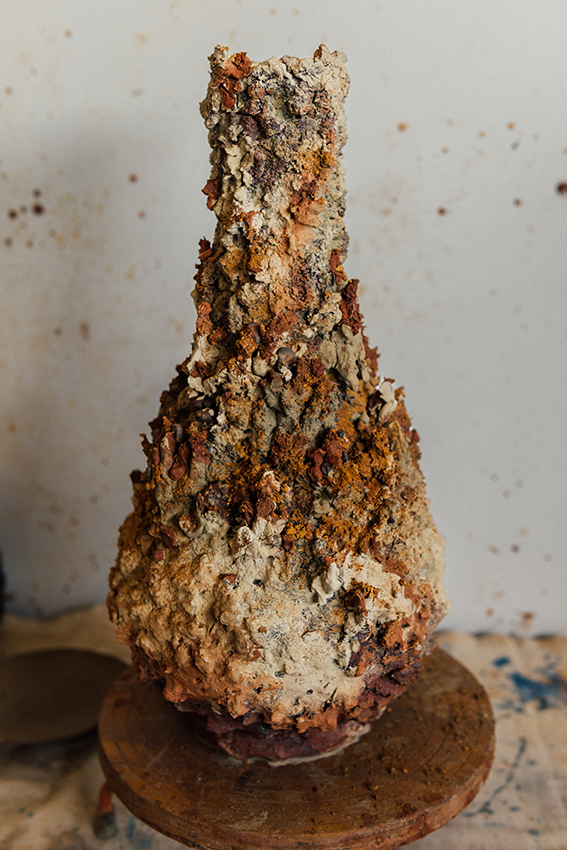
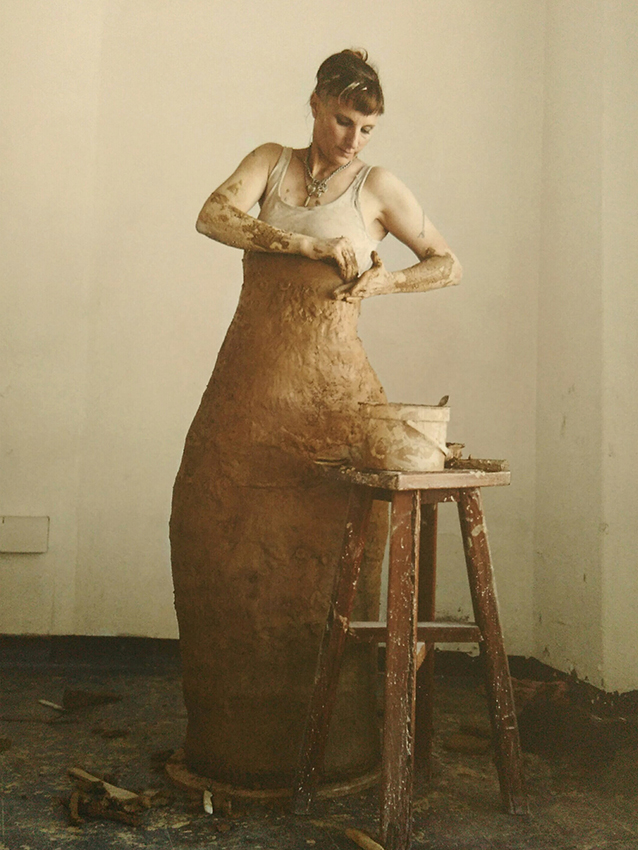
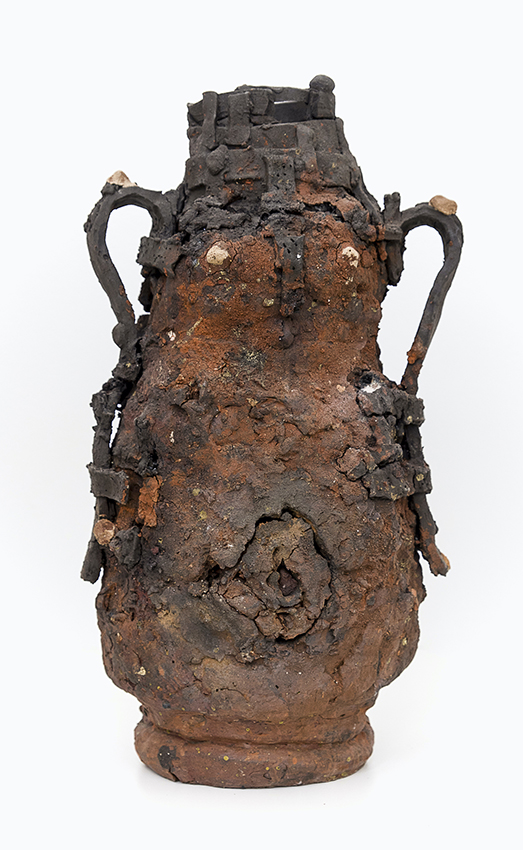
BELINDA BLIGNAUT
Born 1968 (a farm near Oyster Bay, Eastern Cape)
Interdisciplinary artist Belinda Blignaut is committed to wild, hand-dug clay, and its capacity to transform embodied experience. The artist describes this deep connection to the mud as a kind of homecoming – “an ongoing deepening love rather than a making- from-scratch.” Blignaut stages the primordial story of the creature emerging from clay. She has been making work since the late 1980s, emerging as an experimental concept-driven artist on the Johannesburg scene, exhibited further afield at the 1994 São Paulo and 1995 Africus Johannesburg Biennales. In 2019, Blignaut performed her piece Working From The Inside in Vienna alongside artists such as Marina Abramovich and Betty Tompkins. After years of experimentation with medium and body, Blignaut has found herself within the mud. She has become legendary in South Africa for her pioneering practice: forging a new impulse in contemporary ceramics, that of unprocessed wild clay.
(Extract from essay) Many years later, her studio in Woodstock resembled a mud museum, the dappled light rays creeping through the large windows like fingers looking for the earth they knew; there are hundreds of samples of natural wild clay specimens in the form of soil collected in glass jars, buckets of wet earth or clumps of rock like small clay meteorites holding nuggets of stone and ore. Amidst this archive of earth lie delicate animal skeletons, ash samples, quartz, dried leaves, snake skins, and fossilised specimens from another time. The artworks themselves seem to speak to another time – the red earth as it lay millions of years ago like volcanic rock, bearing the impressions of ancient animals as they took their last breath in the mud. Sprouting plant matter and jagged stone teeth half-concealed in the earth. The black shadows, dirty browns, reds, burnt oranges and the mycelium greens and whites of the clay bodies speak to the ancient tones of the earth. Sourcing clay, digging it out of the ground or riverbed, experimenting along- side it and archiving the details of what is encompassed within this medium – these are all fundamental aspects of Blignaut’s process, as is the porousness of her relationship with mud, frequently immersing her own body in it. Wet earth on dry skin acts as a remembrance of an older, integral component of her work – performance – but also perhaps as an intuitive return towards something, the echoes of which we might hear in the writing of Tom Robbins:
“The sea is the cradle we all rocked out of, but it’s to dust that we go. From the time that water invented us, we began to seek out dirt. The further we separate ourselves from the dirt, the further we separate ourselves from ourselves.”



ZANOXOLO SYLVESTER MQEKU
Born 1987 (Tlokoeng, Eastern Cape)
Zanoxolo Sylvester Mqeku is a ceramic artist spearheading the potentialities of clay, sand, and metal. His work emerges in part from a gestating Master’s dissertation, completed through the Central University of Technology (CUT) in Bloemfontein. This self-reflexive research attempts to recuperate ancient ceramic techniques through recent Industry 4.0* fabrication technologies, allowing his medium and practice to come into resonance and dissonance against each other. Mqeku grew up on the outskirts of the Eastern Cape, at the lip of the hills that lead to the Drakensberg mountains. He has obtained several qualifications from Nelson Mandela University in Gqeberha as well as a BTech in Fine Art from the Tshwane University of Technology in Pretoria. In 2018, Mqeku participated in an artist residency in Vallauris (France) and was commissioned as part of the Goethe-Institut Project Space (GPS) in Johannesburg. Working with innovative sand-casting techniques, Mqeku experiments with the many states of earth materials: liquid, crumbling, solid, hardening, excavated, buried. His series The Birth of the Alter-Natural was Africa’s first sand-cast ceramics exhibition.
(Extract from essay) Sand systems hold fragments of lime-petrified plants, volcanic eruptions, the calcareous shells of sea creatures, the frost-bitten sands cast off by Ice Age winds, and roughly hewn mountain quartz. Harvesting sand from the Caledon river, Mqeku builds sandcastles in relief, using moon-white 3D- printed tools to cast enigmatic markings which he presses into the sand. He then pours clay slip into this well and watches as it rushes into the furrows of sand, pressing tenderly into the edges of the imprint, winding its way into remembered forms. When the artist wrests his clay bodies from the womb of the crumbling, crusted cast, the object bears the record of sand.
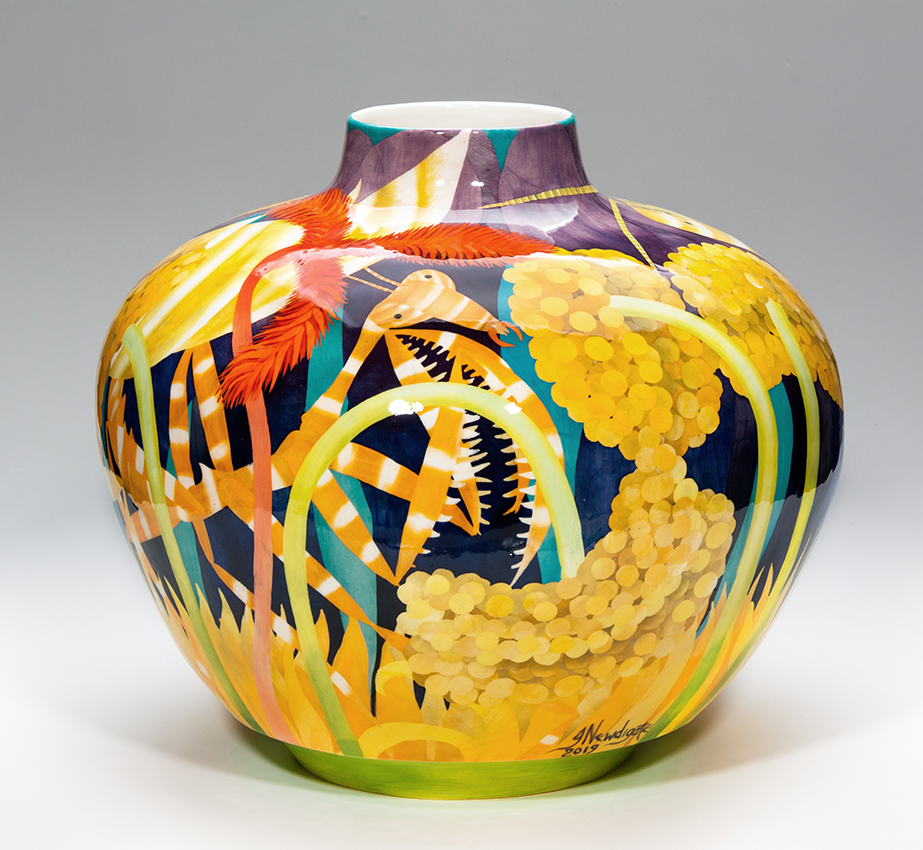

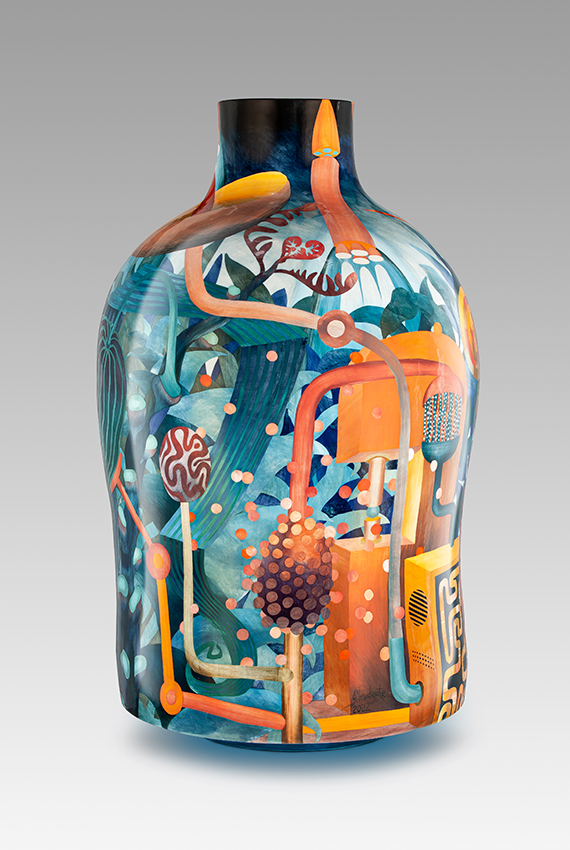
JOHN NEWDIGATE
Born 1968 (Cape Town, Western Cape)
John Newdigate creates the colours you remember, distantly, from your childhood: the deep acrid red, the ripening blue, the warm, aching green, the edible yellow. There are also the scenes you witnessed, lying on your stomach, watching the dramas of insects unfold, the houses sunken into the riverbank, the birds curled in the reeds. He is a colourist, specialising in the painting of hand-built, porcelain vessels through precise yet spontaneous mark-making. Newdigate often works in collaboration with his partner, ceramic artist Ian Garrett, whose forms’ taut bodies house Newdigate’s rich narratives. The artist has exhibited extensively at home and abroad. His work can be found in several significant South African collections, such as the Iziko Museums of South Africa and the South African Cultural History Museum in Cape Town, as well as public and private collections the world over.
(Extract from essay) In capturing this sense of “glossy and colourful” childhood time, gelatinous and dreamlike, the structure of the vessel is essential. Ian Garrett’s contributed forms are not the tabula rasa on which Newdigate inscribes his narratives, but integral machinery of the story itself. The three-dimensional nature of these vessels allows for Newdigate’s scenes to unfold as the viewer orbits the object, a snake’s tail winding around a tree, gaining and disappearing and appearing again. Fragment by revolving fragment, a circular story animates the static object. The archetypal vessel, by its nature, has an orifice, an aperture, an inside and outside. Against Newdigate’s anti-pastoral* scenes, the pot’s dark interior becomes a den, a drey, a hollow tree, a nest. In this way, he gives his creatures shelter. Occasionally, in his bowl scenes, Newdigate ushers his birds inside their nests. This spatial experimentation is essential to Newdigate’s practice – the drawing in of the unimaginably close, the crowding of the frame, the receding foreground and encroaching background.
Newdigate’s forays into mechanical imagery fabulate futurist scenes: the works in his mechanical series are knotted with electrical rainforests rendered in uncanny hues, batteries, and a television satellite that hangs heavy like the head of an arum lily. Newdigate reveals the wilderness of the urban. Organic forms push through concrete. It is a reminder that each fallen city will be conquered by an empire of plants and populated by a kingdom of creatures. As the consummate gardener of colours, he thinks into the minuscule, for it is there, he knows, that those great epics unfold: the tragedy of the fourth extinction, the fight for food, the triumph of an unfurling flower, the glory of dragonfly wings.

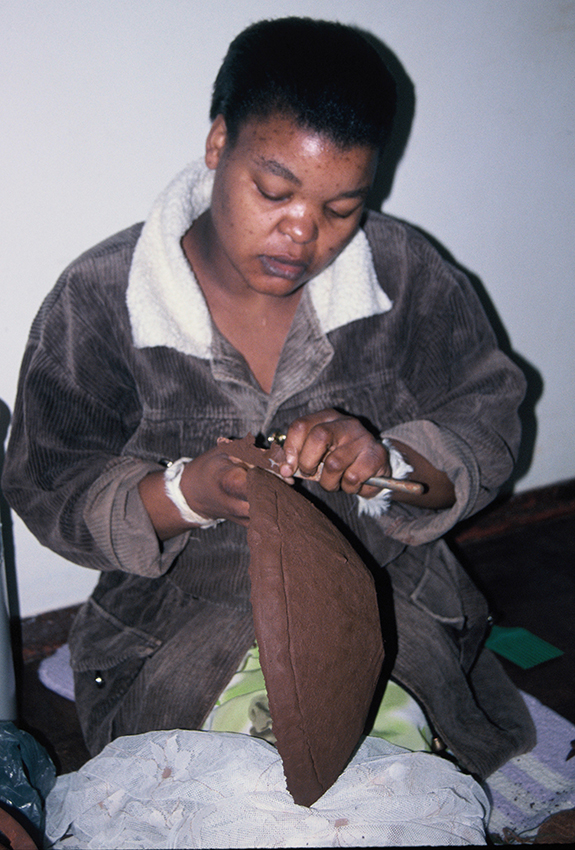
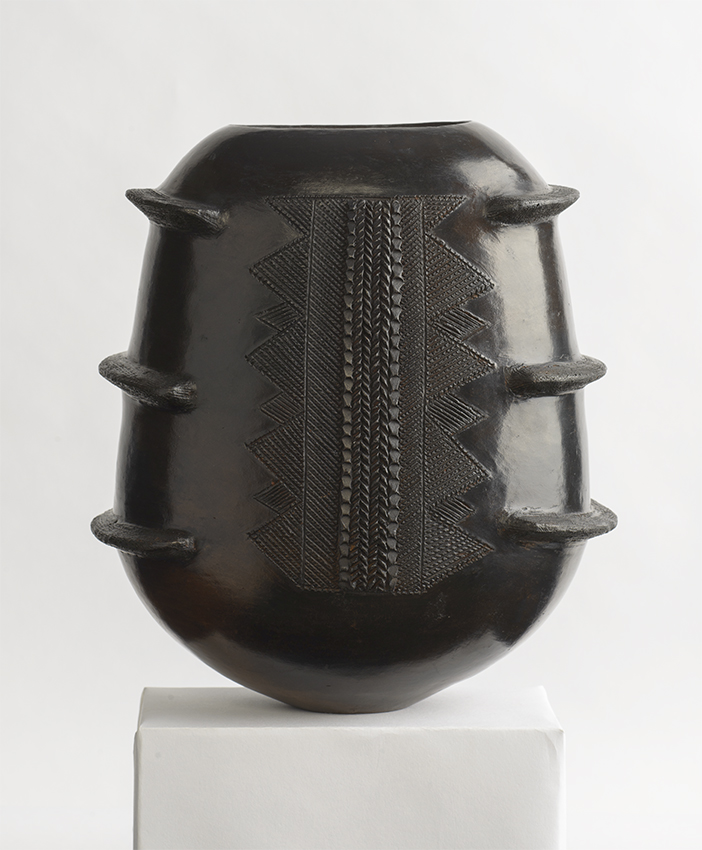
JABULILE NALA
Born 1969 (Eshowe, KwaZulu-Natal)
Hailing from one of the foremost families of Zulu ceramics, Jabulile Nala bears the memory of a line of female ceramicists that can be traced back to 1900. Born in KwaZulu-Natal, and rooted in the ceramic traditions of her mother, Nesta, and her grandmother, Siphiwe, Nala creates sculptural forms which spiral wildly from their origin point in the Zulu clay heritage, at once incorporating and defying traditions. Each work is a distinctive body, perhaps capped with a short protruding neck, or raised amasumpa, or banded design work. Nala digs for red and grey clays from two sites near her home. Her whole-body approach to nurturing her clay from harvest to fabulation is a profound contribution to the lineage of clay and the obscured archives of the women who came before her. Jabulile Nala has participated in numerous exhibitions in South Africa and abroad and her work is represented in both national and international private and public collections.
(Extract from essay) Jabulile Nala has been hand-coiling forms, notably the familial ukhamba and uphiso, since 1980. Her work often pays tribute to the characteristically dainty bases of her mother’s pots and the richness of their motifs: the power and symbolism of the triangular form, especially in juxtaposition with the vessel’s curved outline. Jabulile Nala has innovated even further: compressing the round belly of the ukhamba, flanking its sides with handles more commonly found on traditional meat dishes, and providing a larger surface on which to incise and sculpt a myriad of minute geometric structures. “The ukhamba [is] an object of cultural communication, both in its moment of creation and when on display in the household altar or otherwise. [It] intersects with assumptions of ‘temporality, wholeness, and continuity,’ concepts of authenticity that affect not only the way that Zuluness is perceived externally but also how it is constructed within moments of self-expression.”14 Once the ukhamba lands in the hands of Jabulile it is sodden with waves of history, heavy and warm with all the bodies that have made it. Her mother’s hand, her breath, and the bodies and spirits of the long line of mothers before, appearing in each incision, each coax, each pull of the clay. This artistic and cultural continuity is held in revolutions of form, the flashes of “idiosyncratic flare” are in fact, perhaps paradoxically, great acts of preservation. To hold the ukhamba is to remember a long tradition of art and ritual. To transform the ukhamba is to keep the pot alive, to sustain a vital force, like tending to a garden or telling a story.



